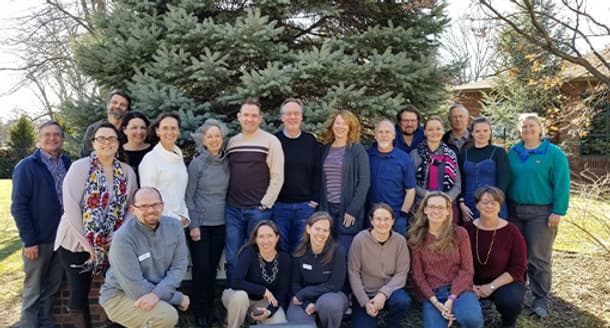AZA Reproductive Management Center (RMC)
Reproductive management is essential to meeting genetic and demographic goals, enriching the lives of animals and supporting the long-term sustainability of captive populations. Temporarily preventing breeding in some individuals while promoting breeding in others is fundamental to successful population management. When genetically valuable animals fail to reproduce, the population is compromised both genetically and demographically; likewise, unplanned births can undermine careful population planning.

-

About Us
Learn more -

Contraception
Learn more -

Reproductive Enhancement
Learn more -

Reproductive Health Surveillance Program
Learn more -

Frequently Asked Questions
Learn more -

Resources
Learn more
Areas of Focus
The RMC's Contraception Program maintains a Contraception Database containing over 50,000 records that are analyzed to continually update recommendations on efficacy, dosing, frequency of administration, and reversibility. The Reproductive Health Surveillance Program (RHSP), an RMC partner, studies the safety of contraceptives through comprehensive pathology examinations and analyses of reproductive tracts submitted by zoos and aquariums. Additionally, the RMC works with commercial partners to facilitate access to new contraceptive methods to the Association of Zoos and Aquariums (AZA community, often at reduced cost. Ongoing communication and data sharing between the RMC and members of the AZA community are critical to research efforts as well as overall program operation.
Successful reproduction in recommended pairs is critical to population management, yet only 20% of breeding recommendations are fulfilled across AZA SSPs (Faust et al., 2019). While some failures can be attributed to logistics, more research is needed to identify the nuanced biological and social causes of reproductive failure. Emerging topics of study related to Reproductive Enhancement include identifying causes of female infertility and pair incompatibility, with the goal of improving reproductive success in affected individuals. Working with the AZA Population Management Center (PMC), and the Reproduction and Endocrinology Scientific Advisory Group (RESAG), the RMC promotes a holistic approach to evaluating reproductive failure, one that examines all possible elements (e.g., nutrition, behavior) rather than focusing on physiology alone. Two of the RMC’s areas of focus in reproductive enhancement are Reproductive Viability Analysis (RVA) and Lifetime Reproductive Planning.
A Reproductive Viability Analysis (RVA) analyzes the breeding recommendations made in Species Survival Plan® (SSP) Programs in the past in order to identify which characteristics of animals in breeding pairs are correlated with reproductive success and are thus the most important to consider when making future breeding recommendations. Examples of these factors include age, prior reproductive history, moving animals between facilities, rearing methods, etc. The results of these analyses aid population managers in making breeding recommendations that are more likely to succeed, which will improve breeding efficiency. RVA results may also be used to increase long-term population sustainability, providing better insight into how or whether the population will be viable in the long term (Franklin et al. 2021).
The RMC has worked with the following Species Survival Plan® (SSP) Programs on RVA:
- Fennec fox (Vulpes zerda); Bauman et al. 2019
- Mexican wolf (Canis lupus baileyi); Bauman et al. 2019
- Asian small-clawed otter (Aonyx cinereus)
- Red River Hog (Potamochoerus porcus)
- American red wolf (Canis rufus)
Are you interested in an RVA for your SSP? Please contact us at contraception@stlzoo.org for more information.
In some cases, reproductive failure is caused by uterine pathologies that are associated with delaying the age at first reproduction, going prolonged periods without producing any offspring, or using certain contraceptives. The phrases “use it or lose it” and “breed early and often” are the paradigms generally associated with this issue. However, to shift animal population management strategies to meet these paradigms comes with some major challenges, the most evident being space constraints. Lifetime Reproductive Planning (LRP) identifies possible breeding strategies for individual females to establish fertility in young individuals, minimize the amount of time between pregnancies, minimize exposure to contraception, and maximize reproductive success while balancing the genetic and demographic needs of the population. LRP is conducted using a Vortex modeling framework, which is capable of incorporating the results of an RVA into the population viability models. LRP provides insights into potential reproductive strategies for females that will enhance fertility and reproductive success in a managed population, while working within that population’s demographic constraints.
Achieving sustainability of AZA populations requires the coordinated efforts of members who are committed to AZA's mission and who represent diverse expertise. The RMC works closely with the AZA Population Management Center (PMC), Taxon Advisory Groups (TAGs), SSP Program Leaders, and relevant Scientific Advisory Groups (SAGs) to address population-level threats to sustainability. The RMC also collaborates with our European counterpart, the EAZA Reproductive Management Group (RMG) to harness data and expertise from both major zoological regions to provide robust reproductive management advice. Another collaborator is the Reproductive Health Surveillance Program (RHSP).
CONTRIBUTE YOUR DATA
AZA RMC/EAZA RMG Contraception Database
The Association of Zoos and Aquariums' Reproductive Management Center (AZA RMC) maintains a contraception database with the European Association of Zoo and Aquaria's Reproductive Management Group (EAZA RMG). This contraception database contains over 50,000 records that are analyzed to continually update contraception recommendations on efficacy, dosing, frequency of administration and reversibility for a wide variety of animals.
The RMC relies heavily on institutions to contribute contraception data for their animals to our database. The data collected include animal information (e.g., taxonomy, age, weight), contraceptive products used, doses, frequency and number of treatments used, implant removals, contraception outcomes (e.g., birth control failures, reversals, etc.), as well as behavioral and physical changes observed during use.
The Reproductive Health Surveillance Program
The RHSP is a tissue archive based at Michigan State University of reproductive tracts from zoo and aquarium animals. Tissues submitted by participating institutions are analyzed and archived in a pathology database available for collaborative projects that benefit AZA Programs (TAGs, SSPs, etc.). This archive allows us to detect disease patterns associated with various methods of reproductive management and identify best practices. AZA facilities are strongly encouraged to submit reproductive tracts from contracepted and uncontracepted animals to this archive. Submission instructions are found below.
Communication
Communication with the broader zoo and aquarium community is a vital component of the RMC’s mission. Types of communication include:
- Attending AZA conferences to present at AZA Taxonomic Advisory Group (TAG) and Species Survival Plan (SSP) meetings, and to participate in the meetings of other SAGs and Committees
- Reaching out to the veterinary community by attending and giving presentations at the American Association of Zoo Veterinarians (AAZV) and Association of Zoo Veterinary Technicians (AZVT) conferences
- Publishing peer-reviewed research related to reproductive management
- Providing contraception data to the PMC prior to SSP planning meetings as necessary so that the number of breeding recommendations can be adjusted to account for likely time to reversal following contraceptive treatment
- Contributing contraception and reproductive management sections to Animal Care Manuals and SSP Breeding and Transfer Plans as necessary

